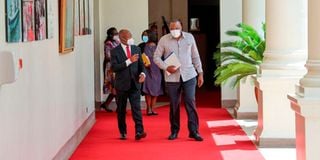Children will bear consequences of war in Great Lakes region

President Uhuru Kenyatta (right) and João Samuel Caholo, the Executive Secretary of the International Conference on the Great Lakes Region at State House, Nairobi, on April 27, 2021.
Children born today in the Great Lakes Region will suffer the consequences of persistent violence even if fighting stopped now. This signals a long-term impact on communities battered by fighting.
The verdict came from João Samuel Caholo, the Executive Secretary of the International Conference on the Great Lakes Region (ICGLR). In an interview with Nation. Africa, Mr Caholo warned that the “cyclic violence” in the region means the impact of war will be suffered by the present and future generations.
He spoke in Nairobi after a meeting with President Uhuru Kenyatta where they discussed Kenya’s contribution to regional peace and security, especially as a member of the UN Security Council.
But as the head of the Secretariat of a body charged with coordinating, facilitating and monitoring a pact on security among its 12 member states; the verdict was grave on just how violence pummels both the living and the yet-to-be born.
“Our first challenge is seeking peace and stability for our region,” he told the Nation. Africa in an interview on Friday.
“The second are the consequences that result from constant conflicts in its member states: Refugees, statelessness, gender based violence and impact on the future of our children. Our Children’s future cannot be guaranteed until the root causes of violence are addressed.”
Crucial cases
Caholo,65, an Angolan diplomat trained as a geologist at university. But he has been close to issues of regional peace and security for as long as the last two decades. Representing the ICGLR, his secretariat based in Bujumbura works for peace in Angola, Burundi, Central African Republic, Republic of Congo, Democratic Republic of Congo, Kenya, Uganda, Rwanda, Republic of South Sudan, Sudan, Tanzania and Zambia.
As he travelled to Nairobi last week; two crucial cases were on his mind: the butcher of civilians in eastern Congo by unknown merchants of violence and the continual conflict in the Central African Republic. The ICGLR held two mini summits on the Central Africa Republic, where violence began as soon as December elections were held. The Unicef said last week that some 738,000 people had been displaced. Half of them were children meaning the country was experiencing the highest child displacement since 2014.
Unicef warned of the mounting risks for children, including exposure to sexual and physical violence, recruitment and use by armed forces and groups, increasing rates of malnutrition and limited access to essential services.
“We still have consequences of cyclic crises in the region. Look at what is happening in the Central African Republic, we have just had two mini summits because of the situation in that country,” posed the ICGLR official, when asked on progress for peace in the region.
Economic growth
“Look at what is happening in eastern [DR] Congo. Just three weeks ago, people were literally butchered in Goma. Two months ago, an ambassador was killed in Goma. How can I say we have made progress?
When the ICGLR was formed in 2006, it was following a proposal by the UN Security Council to have a regional collaboration for peace under the thinking that conflict was slowing economic growth even among neighbours. The ICGLR itself had a vision to have the region “transformed in a space of sustainable peace and security, through joint and coordinated efforts and within a regional framework for prevention, management and peaceful resolution of conflicts,” according to a note on its website.
But with wars ending and starting seasonally, that progress has been limited.
“I can only say we have made progress as far as saying we have not had our member states overran by terrorists,” he told Nation.Africa.
“We have made progress in dealing with negative forces in the eastern Congo but still the dynamics of the ground are there. And you will also attach a lot of priority in that regard.”
People displaced
In the DRC, photos emerged of people displaced from a new wave of violence. The incidents in South Kivu were reportedly committed by exiled rebels from neighbouring countries. In North Kivu, houses were torched in early April after rival ethnic groups clashed, resulting in deaths. It is an eruption of violence in an area where some 3,000 people were killed last year including 286 children according to a report by the UN Human Rights High Commissioner.
Two weeks ago, President Uhuru Kenyatta offered to support the capabilities of the Congolese Army while on a state visit to Kinshasa. The support could come in handy against the rebels.
The ICGLR chief hoped collaboration among neighbours will prevent the bite of today’s conflict by allowing the rebuilding of broken institutions and infrastructure.
“We have all the proposals on the table [for development]. But we are not a stable region that is why we are first driving to establish everlasting peace and stability,” he said, indicating participation of member states in various economic blocs.
“We are going to need stability and everlasting peace. Secondly, we need leadership to be able to drive implementation of priority strategic infrastructure projects.”





